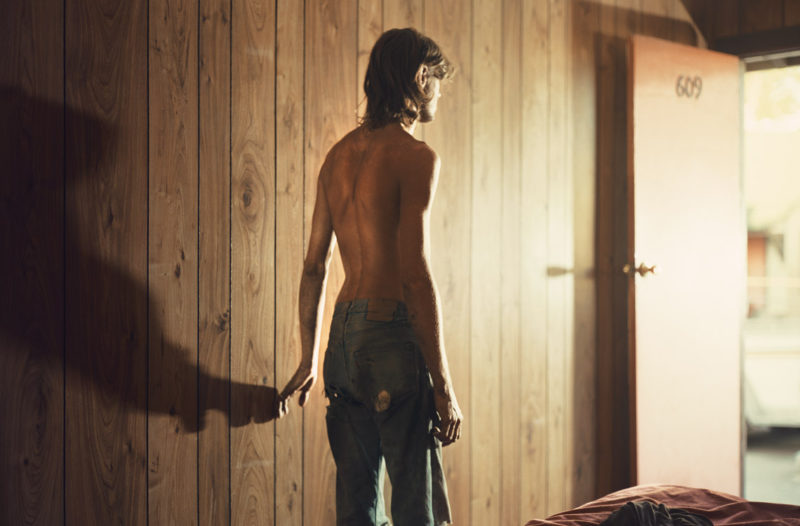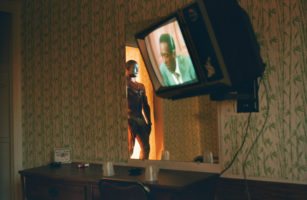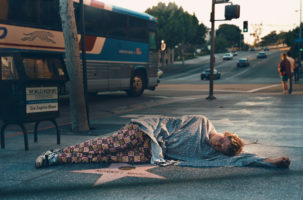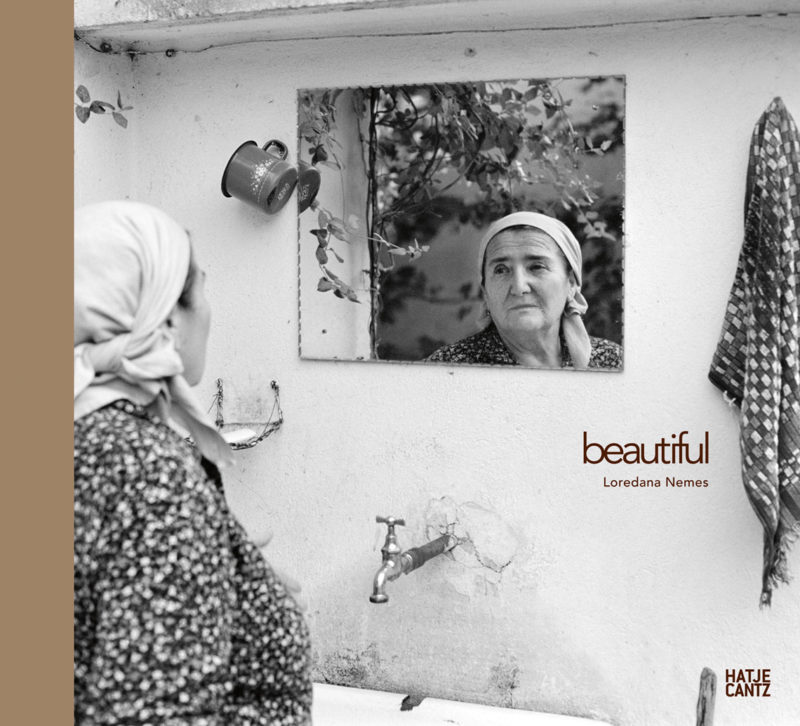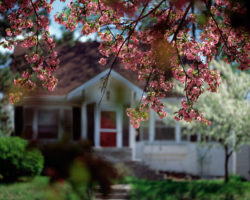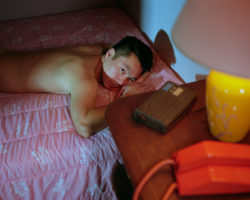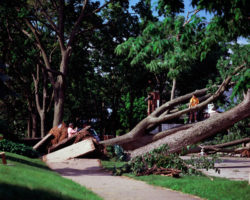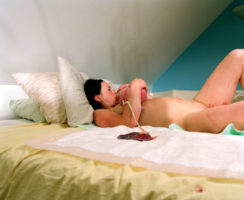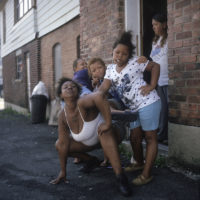Josh Quigley is one of the winners of the 2013 Conscientious Portfolio Competition. Explaining why I had picked his submission, I wrote: “Behind the cookie-cutter facades of their anonymous homes, people go about their private businesses in all kinds of ways, and it’s hard to see what’s wrong with that. Except, of course, that large parts are kept hidden away, possibly only hinted at with carefully constructed euphemisms, for reasons that aren’t entirely obvious (beyond cultural fiats that deserve to be questioned rather severely). People procreate to have babies, or they do everything that’s involved in the act of procreation except for having that baby. Josh Quigley depicts all that in a way that makes the overly beautiful facades looking a tad freakish, while what’s going on behind is given all the attention it really deserves. There’s no ogling, there’s no sensationalism, there’s just a celebration of the human condition, in all its different forms.” Over the past weeks, I spoke with the artist about his ideas behind the work.
Jörg Colberg: “A Shameless Longing” has evolved over the years to include a large variety of photographs, including very personal ones, self-portraits and portraits of your wife and children. Can you talk a little bit about the evolution about the project, how it came about and how you approach it?
Josh Quigley: The project really started forming legs while at the Minneapolis College of Art and Design. But when I think back on it, I was already making work that would prepare me for “A Shameless Longing”. Before graduate school, I was working as a geotech for an exploration company living in Michigan’s Upper Peninsula. It was here that I started photographing some of the town of Marquette’s unique and eclectic individuals. I was already lighting and staging the photos but in more of a “Rolling Stone” cover shoot way, turning everyday people into celebrities. It was a lot of fun, and it’s where I learned to work with people and how to light a photograph.
In graduate school I learned how to combine these elements and add narrative to the image. Staged photography was king at the time, and it was so inspiring to see work that was being produced for the medium by, Gregory Crewdson, Philip Lorca-diCorcia, Bill Henson, Simen Johan and Jeff Wall. I had to be careful not to fall in love with the process more than the resulting photographs (I have many pretty failures). At first, I just photographed whoever would let me and see what would happen. I had to make a lot of pictures before I knew what I was doing and what exactly I had. I was photographing my family, friends, people from Craigslist, modeling websites, whoever would bite.
I was fortunate in that I was limited by my resources and had to make work by standards that others might have considered “scrappy,” but that’s what allowed the work to remain believable, and not become overly “produced.” After graduate school is when everything “clicked.” I was able to really focus on the project that I wanted to make, and I spent the last 4 years doing just that. Having finished the bulk of the work I now have been working on book mock-ups and tighter edits of the project.
From the beginning of the project I had cast a very wide net. So after seeing what I had caught, I started to shape the project by carefully editing it down into what it is now. I have been told that the project should be two projects–one with my family, and one with the strangers–but I feel as though they are complementary to each other. The family pictures are personal and intimate as they should be. These are people that I am close to and have access to in a way that no one else does. I wanted this work to reflect this privilege of intimacy.
The strangers, on the other hand, are less intimate. Although they are very revealing and sometimes overtly sexual, they remain more anonymous in their actions, and they don’t have enough picture presence to develop more of an overall narrative. This is why it was important for me to create portraits that could act as standalone images, images that can be self contained in their narrative and that don’t necessarily need other images to support them – reminiscent of classical painting and the photography of Jeff Wall.
JC: Given you have spent quite some time on the project, have you worked with some sort of “master plan” once you knew what you wanted? How do you know what else you need, how will you know that you’re going to be done?
JQ: I wish I had some sort of “master plan” when I started this project. But no, “A Shameless Longing” is a series of evolutions and adaptations made over the years. Because of the nature of this project it could go on forever, focusing on my family as they change, and grow older, while also bringing in new people to the fray. At this point in the project, I would say I am 95% done with only a few key pictures of my immediate family to be made this spring/summer. The way I chronicled time in my project is through the aging of my two boys. When the project started Joseph was 6, and now he is 14. For Desmond, we see the time before birth until he is 3 years old. I am looking for a middle ground between the two boys where it could appear as the life of just one boy, the same but different, a strange overlap in time where the project comes full circle.
JC: Inevitably, viewers will want to know who the people in the pictures are, how much is set up or real etc. How do you approach this? To what extent does it matter that people get this knowledge (and why)?
JQ: I hope that it does not matter who the people are, for the initial viewing at least. Like a film, you don’t know how the story is going to unfold until you have watched it. I wanted the work to start out anonymous and become more focused as the viewer realizes the narrative thread that turns out to be my family. Part of the allure is that it is both personal and anonymous, which parallels life. There are those you know and are close to, and there are those you don’t know at all. This juxtaposition does not make them, or you, any more or less important. It is just a very small part of life.
Every picture is set up in a manner that is similar to neo-realist films. I am using the technology and the means to tell a story that is based in the real world with non-professional actors and models. I create a scene where I point the camera in a particular direction, I light that area, and vaguely stage the action (if possible) and let happen what’s going to happen.
Much like the film director shooting the scene of a movie, when I yell “Action” I can never be sure what to expect. I am still surprised by the moments that can be captured. That is what photography does so well, capturing brief moments in time, freezing them so we can look closer, studying them as though we too, have become removed from time.
In general I think people look at photographs and accept them as truth (advertising aside). That is why photography is always getting into trouble for its trustworthiness, but it is also what makes photography so powerful still.
I think my work walks a fine line between what is real and what is staged, therefore asking interesting questions about what it means to make documentary work today and the overall validity of a photograph. After all is said and done, I hope the work speaks to the audience and stirs up emotions within the individual viewer. They don’t have to like the work, but I hope that the work leaves a lasting impression.
JC: The project also contains a fairly large number of beautiful, almost too beautiful photographs of anonymous houses and landscapes. I’m curious about how those came about and how you see them function in the context of this work.
JQ: I knew I had to make pictures that connected the people to the landscape, but it wasn’t until the fall of 2010 that I made my first successful images. I spent the following winter coming up with a list of ideas for how I wanted these photos to look, which resulted in a set of rules or guidelines that I would try to abide by.
First rule–All pictures had to be taken during the middle of the day, during the summer when the days were long and there was plenty of greenery and foliage on the trees. Also, this is supposedly the ugliest time of day to shoot according to most landscape photographers, as everything becomes top lit with very severe shadows. Since this project was shot in Minnesota where there is snow on the ground for half of the year, I wanted to make sure it could look as hot and bright as possible.
Second–I was going to shoot all the pictures using Fuji Velvia slide film, the number one film for shooting beautifully colored (some may say oversaturated) landscapes.
Third–All pictures were going to be shot with a telephoto lens with very shallow depth of field to really push the voyeuristic look to the max. I wanted a forced perspective that would directly contrast against the interiors’ exaggerated use of three-dimensional space. The idea was that the interiors would represent the vast internal space of the human psyche, and the exteriors would be this flat, unexplored space where people are inhibited from expressing themselves.
Fourth–There would be no people (preferably). I wanted to create incredibly beautiful images that were full of light but also shadow and darkness, reminiscent of film noir and horror films, but also like children’s fairy tales with just a little bit of Thomas Kinkade thrown in. These would be the habitats, the nests, the homes as they were found in the natural world.
I set out to photograph them like a nature photographer, always from afar, zooming in on a small piece while always being conscious of the third-person perspective used so effectively in the horror movies from my childhood. My intention was not for me to be the voyeur, but to create a perspective that becomes the viewer’s entrance to the work. It’s not neutral, it’s purposefully directed.
This was also about the time that Aperture re-released Robert Adams seminal “Summer Nights Walking,” which was incredibly influential to me, as I am sure it has been for many photographers throughout the years . This book was important to me not just for the pictures but for how I imagined Robert Adams making the work, wondering the streets at night, a camera and a tripod, finding beauty on the fringes of a city, looking for that intersection between the natural world and man’s increasingly dominant domain over the land. I found myself fantasizing about making similar images, but I knew I wanted to do it under the harsh light of day.
Also quite important was the fact that I was going to be a stay at home parent with our son Desmond. So I had to find a way to work that wasn’t as demanding as the portraits were to produce. Desmond spent all of his naps that first summer either being pushed in a stroller or in his car seat, while I walked or drove, looking for locations and dwellings to photograph. When I did come across a scene that interested me, I would first use my digital point-and-shoot wrapped around my neck (that made me look like a dorky dad ) and shoot a few test pictures to see how a picture might look shot on film. If it was interesting, I parked the car or put the brake on the stroller, and pulled out my Mamiya RZ67 and took a few pictures before drawing too much attention to myself. The RZ67 was not inconspicuous in the least, and it made me feel as though I was pointing a bazooka at someones house.
Needless to say, some people wondered what I was up to. It’s funny, but even with all the pictures of nude people in my work I always felt the most uncomfortable, nervous, and even guilty, while I was photographing people’s homes during the middle of the day and always from a public vantage. I guess I felt as though the house was the most vulnerable and couldn’t speak for itself.
It’s not just the homes that are important to my landscapes, but it’s also about the trees and plants that surround the homes. These trees in many cases have been in their location longer than the homes, and they represent an element of time and a link to the natural world. The homes are being obliterated by the lens, by fire or they are being taken over by nature and shadow. There is an element of danger, law of the jungle, combined with animal instincts, survival of the fittest and survival of the species. The house is also used as a symbol for the body, fragile and at mercy to its environment.
JC: With many photographs depicting sex or its “aftermath” (someone having a baby etc.) I’m wondering how you navigate this area. Given the times and culture we live in artists get typecast so easily. Is this a worry for you?
JQ: To be typecast I think I would have to only make work of one subject or another. At least for me the work represents a vast exploration of the themes and emotions that are possible within the domestic life. This is also one of the reasons that I spent so much time focusing on bringing in the landscape to the project. Not only does it provide a setting for my story, but it also gives some of the more intimate pictures some breathing room, a place for the viewer to be able to rest before moving on.
I have shown some of this work before, and I felt that the work was often reduced to the most “sexual” or “sensational” pictures, which saddened me and made me pull back and reevaluate how I wanted the work to be received as a whole.
It was important for me to incorporate as many facets of sexuality as possible. Not just sex itself, but how sexuality shapes us today and how we incorporate what it means to be feminine and masculine. I wanted to play with sexuality throughout the project so that the viewer has a chance to address their own ideas of sexuality.
Today, we are bombarded by violence in the media, on the TV, in movies, video games. Sex, if shown, is always over-sensationalized to be titillating or bearing guilt. Hence the title “A Shameless Longing” which means to bear no guilt, to have no shame, like an animal, to be natural. It’s also a play on words in that today “shameless” has also come to mean a person who has no shame, i.e. someone who is willing to do anything for fame and money.
It would be difficult to have a project about sexuality and not incorporate birth and its implications to the overall narrative. As a photographer I totally lucked out knowing that my wife Susan and I were planning on having a home-birth with our son Desmond. I was given an opportunity to show birth in a home environment and what that could look like, and how to some it might seem incredibly grotesque. Contrary to what society views as normal, birth isn’t that complicated. It’s something incredibly personal but natural and something that can be done in your own personal space. Again, it’s accepting what the body does naturally and trusting those ingrained primitive instincts.
My only real worry is that people will not see the work the way I intend for it to be seen. I want the work to be able to reach as many different types of people, not just the ”in the know” art world, and to impact people equally. I imagine a large dark space (like a theater), where there is a film that has been chopped up into its many parts, each illuminated, floating in the darkness. The viewer enters this world that I have created, suspending any disbelief and feeling their way through it. This is how I have imagined the showing of “A Shameless Longing.”
, the narrator chronicles how he destroys a relationship with a woman through a series of rather ill-advised decisions. One of them involves traveling to a town in Russia repeatedly, first to try to find traces of Andras Tamas and later to produce a documentary about something, where it’s never quite clear what that something is (the narrator makes it clear he doesn’t quite know). The relationship is one of the threads running through the book, there are more. I ended up enjoying the events – or rather non-events – in Russia the most, in part because I have a weakness for travel writing when it’s done well (many of the other parts of the book, especially near the end, are a bit too gratuitously self-indulgent for me).


